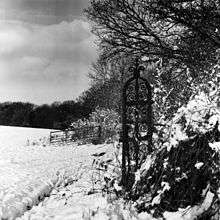Lord John Grey (Tudor nobleman)
Lord John Grey (1523/24 – 19 November, 1564) was an English nobleman and Tudor courtier, who was seated at Pirgo Place after 1559.[1]
Lord John was at one stage sentenced to death for his involvement in Wyatt's Rebellion against Mary I, but was later released from attainder. Grey was restored to his original position by Queen Mary's successor, Elizabeth I; Queen Elizabeth also granted him Pirgo Place in Essex as well as making him Guardian of Lady Catherine Grey, his niece, and sister of the late Lady Jane Grey, in 1563. However, Lord John was again imprisoned shortly before his death, after publishing a book asserting Catherine [Grey] to be the legitimate heir to the English throne.
Lineage
Lord John Grey was the youngest surviving son of Thomas Grey, 2nd Marquess of Dorset and Margaret, widow of William Medley, and daughter of Sir Robert Wotton, of Boughton Malherbe, Kent.[2]
His elder brothers, Henry, 3rd Marquess of Dorset (created Duke of Suffolk in 1551) and Lord Thomas Grey, were executed for treason on Tower Hill in 1554.
Grey married Mary Browne, daughter of Sir Anthony Browne KG by his first wife, Alice née Gage.[3]
Children
Lord and Lady (née Mary Browne) John Grey had three sons and four daughters including:
- Henry, 1st Baron Grey of Groby who, seated at Pirgo Place, re-established the Grey family presence both at court and at their ancestral domains including Bradgate and Groby in Leicestershire; Lord Grey of Groby's grandson became the 1st Earl of Stamford.
- Margaret, wife of Sir Arthur Capell, of Hadham and High Sheriff of Hertfordshire in 1592, reputed to have had eleven sons and nine daughters; ancestors of the Barons Capell of Hadham then Earls of Essex.
- Frances, wife of Sir William Cooke, of Highnam, Gloucestershire, son of Sir Anthony Cooke KB, of Gidea Hall, near Pirgo Place, Essex.
- Elizabeth, wife of Sir Henry Denny, of Cheshunt, Hertfordshire; ancestors of the Denny baronets.
- Jane, wife of Sir Edward Greville, of Harold Court, Essex; younger brother of Fulke Greville, 4th Baron Willoughby de Broke.
Royal service
Grey was appointed Lord Deputy of Newhaven (now Le Havre) in France[4] in charge of the English fortress then being strengthened and given extra storage facilities. Lord John then received grants from Edward VI of the rectory of Kirby Bellars and other estates such as Bardon Park in Leicestershire, and in his ancestral home county of Derbyshire as well as in Nottinghamshire, affirmed by Queen Mary.
Wyatt's Rebellion
Lord John Grey and his brothers became involved in Wyatt's Rebellion which proposed to replace Catholic Queen Mary with her Protestant half-sister Elizabeth for which he was condemned to death. His brothers, Henry Grey, 3rd Marquess of Dorset (later Duke of Suffolk) and Lord Thomas Grey, were both executed but with the backing of his Catholic father-in-law, the Viscount Montagu, Lord John Grey was released though still under attainder, and lived in obscurity until the death of Queen Mary. Grey became his father the 2nd Marquess's sole surviving son and heir but was deprived of succeeding to the family marquessate, forfeited in 1554, thus being unable to sit in Parliament.
Lady Jane Grey, his niece, had already been sentenced to death for treason before Wyatt's Rebellion and was executed the month after the rebellion.
Queen Elizabeth's accession

An iron gatepost surviving from the former Tudor royal palace
Lord John was summoned to court as head of the Grey family, attended Queen Elizabeth's first progress into London and gave her a costly gift on the first New Year's Day of her reign. A few months later he complained of poverty to Lord Burghley, her prime minister, and the Queen granted him the royal manor of Pirgo, Essex and its mansion, as well as lands in Somerset. He was "restored in blood", released from the Act of Attainder and appointed one of the four Protestant noblemen to supervise alterations to the Book of Common Prayer.
Lady Catherine Grey
Lord John's niece, Catherine, Lady Jane Grey's younger sister and heir presumptive under the Will of Henry VIII, had married secretly in 1560 without royal assent. The marriage was quickly discovered and Lady Catherine Grey was confined to The Tower. Released under house arrest in 1563 for the safety of her health during an outbreak of plague she was moved to Pirgo Place under the care of Lord John Grey. However, after a book circulated claiming Lady Catherine to be the rightful heir to the English throne and not Mary, Queen of Scots, Queen Elizabeth removed Catherine from Lord John's charge and took him briefly into custody.
Lord John Grey died a short time later at Pirgo on 19 November 1564 and was buried in the estate's domestic chapel. His son inherited Pirgo Place and was later created Baron Grey of Groby.
See also
Notes
- ↑ Lodge's Peerage (1842)
- ↑ Richard Davey. The sisters of Lady Jane Grey and their wicked grandfather, E.P. Dutton and co., 1912. pg 199-200. Google eBook
- ↑ Douglas Richardson. Magna Carta Ancestry: A Study in Colonial and Medieval Families, Genealogical Publishing Com, Jul 30, 2005. pg 392. Google eBook
- ↑ www.british-history.ac.uk
References
- Burke's Peerage & Baronetage
- Lehmberg, Stamford. "Grey, Lord John (d. 1564)". Oxford Dictionary of National Biography (online ed.). Oxford University Press. doi:10.1093/ref:odnb/11548. Check date values in:
|access-date=(help); (Subscription or UK public library membership required.)